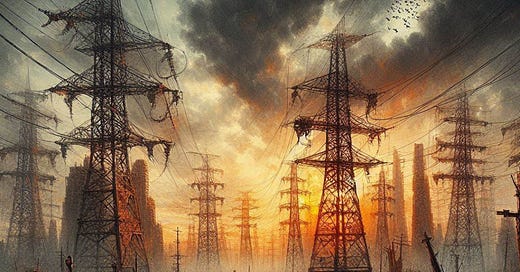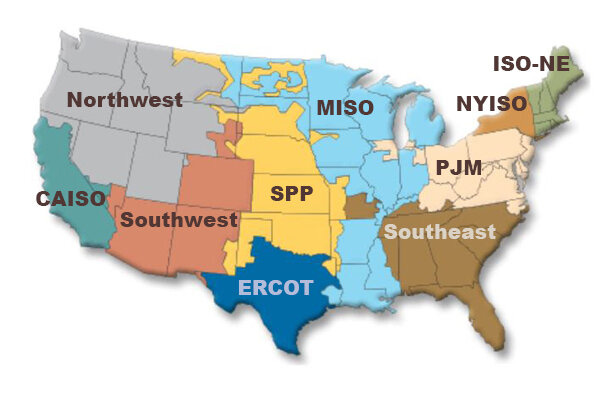Watching the Fatal Trifecta Unfold
The EPA's new emissions rules, MISO's capacity auction, and the fragilization of the grid
Last spring, the members of the Federal Energy Regulatory Commission had chilling words for the Senate: America is losing reliable power plants, building unreliable ones, and heading towards a reliability crisis. “The red lights are flashing and there is no excuse not to see them,” said Commissioner Mark Christie, adding, “I believe it is my duty as a member of FERC to call attention to the serious threat to reliability that is looming on the horizon.” If the Senate listened, the Environmental Protection Agency did not, opting to make the problem worse.
Last week, the EPA announced a finalized version of its new rules on power plant emissions. The road to finalization has been quite the saga: in 2023, when the rules were first floated, they garnered serious backlash, especially from America’s grid operators, several of whom said that this initial version of the rules could “exacerbate the disturbing trend and growing risk wherein the pace of retirements of generation with attributes needed to secure grid reliability is rapidly exceeding the commercialization of new resources capable of providing those reliability attributes.” In other words, if enacted, these rules would kill off baseload power plants without adequate replacements because America is mostly building wind and solar.
This updated ruleset has received a similar response to that of 2023. “The path outlined by the EPA today is unlawful, unrealistic and unachievable,” National Rural Electric Cooperative Association CEO Jim Matheson said. “It undermines electric reliability and poses grave consequences for an already stressed electric grid.” Matheson’s organization represents 900 local electric cooperatives across the country.
So, what are these new rules about? Essentially, the EPA wants to kill coal. And it wants to kill coal by making it too expensive to own and operate a coal plant. If a coal plant wanted to run past 2039, it would have to deploy carbon capture and storage technology (CCS) by 2032. Of course, CCS is not ready for prime time and not affordable. The EPA also wants to give coal plant owners a way out: if they shutter their plants by 2032, then they’re exempt from the rules. It’s a pincer move.
And there’s more to the rules than that—check out this from Energy Bad Boys for a solid breakdown—but we’ll get to that later. Prognosticating the impact these rules would have on the grid takes little effort. All we have to do is take a look at the middle of the country, namely the Midcontinent Independent System Operator, or MISO.
For those not in the know, MISO is a power market where power plant owners bid into an auction to supply power to the grid. MISO operates a few different auctions on different time scales to guarantee reliability. One such auction is the “seasonal capacity auction” wherein power plant owners bid in to be on deck for the grid’s future power needs. The seasonal capacity auction serves two main purposes: ensuring reliability and sending price signals that incentivize investting in reliable power plants. MISO’s latest capacity auction results reveal a disturbing trend that the new EPA rules would only exacerbate.
MISO’s upcoming summer and spring seasons saw prices triple to $30/MW-day and $34.10/MW-day, respectively, spanning the whole Midcontinent. Some sections of MISO saw fall and spring season prices jump to $719.81/MW-day; in the last auction, the prices were $15/MW-day and $10/MW-day, respectively. What’s the impetus for this wild increase in prices? Power plant retirements (and in some cases planned maintenance) that are sapping the region of surplus capacity.
The results confirm something the CEO of MISO said earlier this year:
We have to face some hard realities. There are immediate and serious challenges to the reliability of our region’s electric grid, and the entire industry — utilities, states and MISO — must work together and move faster to address them. […] Studies conducted by MISO and other entities indicate it is possible to reliably operate an electric system that has far fewer conventional power plants and far more zero-carbon resources than we have today. However, the transition that is underway to get to a decarbonized end state is posing material, adverse challenges to electric reliability. [emphasis his]
Let’s sum this whole thing up in plainer English: MISO is seeing reliable power plants (like coal) retire before any utilities can replace them, which wind and solar cannot do because they can’t be dispatched when the grid needs them; so prices are going up as reliability goes down.
But can’t utilities within MISO just pivot to gas? Not so fast — the EPA rules head that route off at the pass, too. Its finalized emissions rules require new gas plants that run only 40% of the time to capture 90% of their emissions by 2032. This guarantees fewer gas plants will be built.
And MISO knows this. In their recent Reliability Imperative, the grid operator reported three major challenges to securing a robust, reliable energy portfolio:
Tightened EPA regulations that would force premature gas and coal retirements
Investment criteria that makes investing in gas or coal too challenging for investors “even if it is critically needed for reliability purposes”
The inbound $370 billion in subsidies for wind and solar from the Inflation Reduction Act
So, why doesn’t MISO take matters into its own hands and call on utilities to keep certain plants online? Because they legally can’t. They can create auctions that provide better incentives for baseload owners, but if those incentives are hijacked by distortionary prices and regulations, there’s little a grid operator can do. They’re policy takers, not policy makers.
Now, combine this state of affairs with the national forecasted increase in power demand. According to the Energy Information Administration, power demand is projected to hit record highs this year and next. Through 2028, America is forecasted to add 38 GW of electricity demand—equivalent to adding a California’s worth of demand.
These dynamics will exacerbate what
(subscribe to her Substack!) calls the “fatal trifecta”: “overdependence on 1) renewables, 2) just-in-time natural gas, and 3) imports from your neighbours.” MISO imports from and exports to neighboring power markets. In December of last year, NERC warned that 110 gigawatts of reliable, dispatchable generation will retire through 2033. The EPA’s regulations will hit MISO’s neighbors, too.Here’s what’s important to remember: the activists and regulators pushing for these rules do not care about system reliability. They want to punish the fossil fuel industry, shut down coal, and force utilities to build more wind and solar. That’s the point of the EPA’s new emissions rules. As Emily Pontecorvo and Robinson Meyer explained in their coverage of these rules last year, “some environmentalists will admit—although not on the record—that they like the rules for this reason.”
Consequences are someone else’s problem; they have the world to save.







It also may not matter who wins the next or next two presidential elections unless legislators can gain direct influence over the administrative state. You can sue them but the response time and uncertainty is an investment killer
We need an oversight agency tasked with overturning rules and regulations of other agencies based on a reasonable cost benefit consideration. Give Congress the reins back
Merideth's fatal trifecta should have a virtuous twin. Anyone involved in this process should be held criminally accountable if they make decisions based on anything but these three criteria: reliability, physical safety of individuals, reasonable prices for consumers.